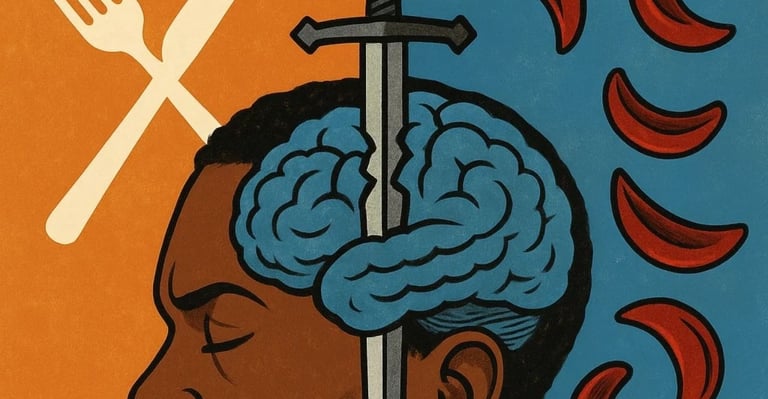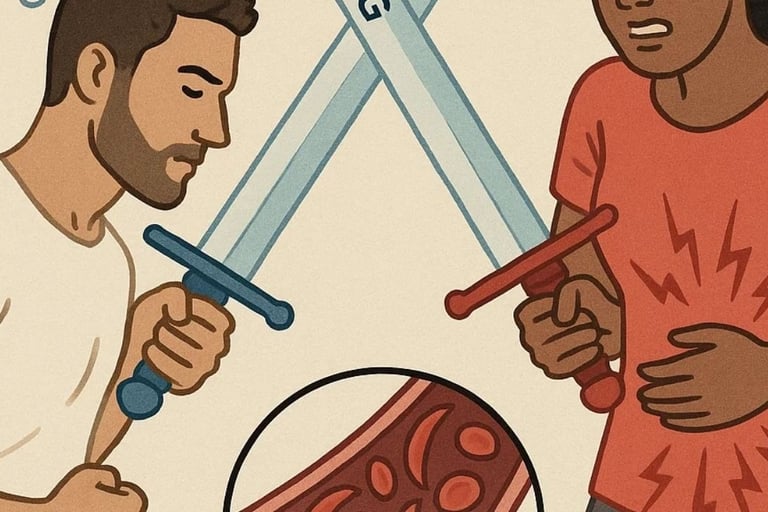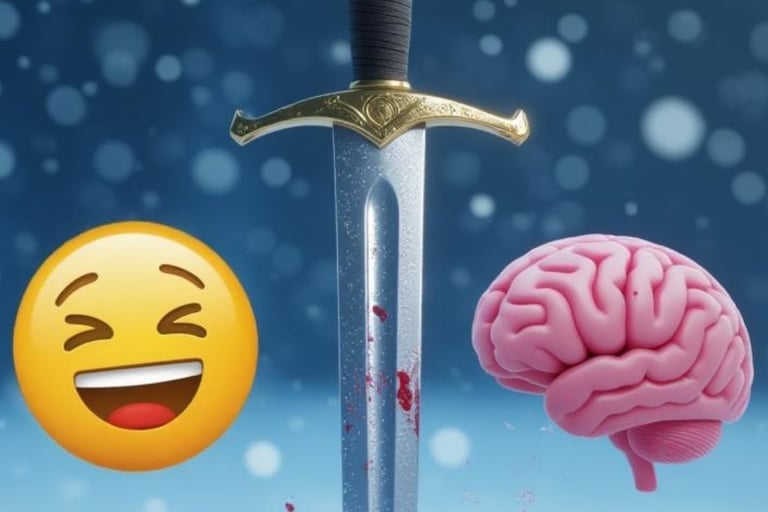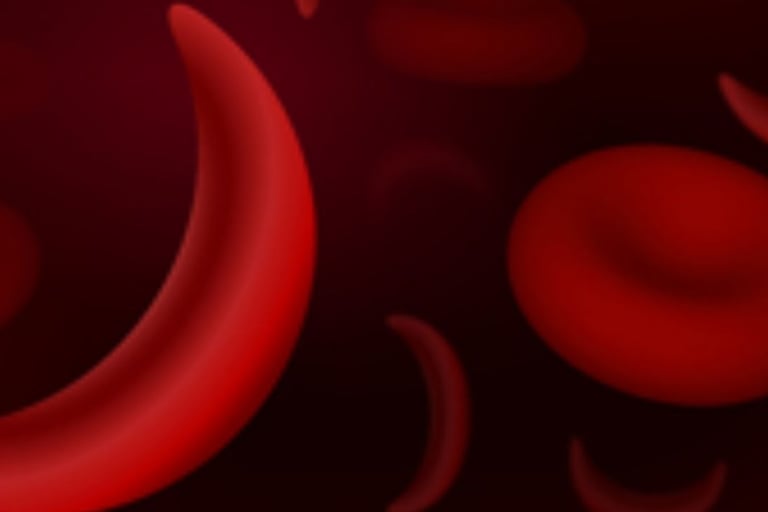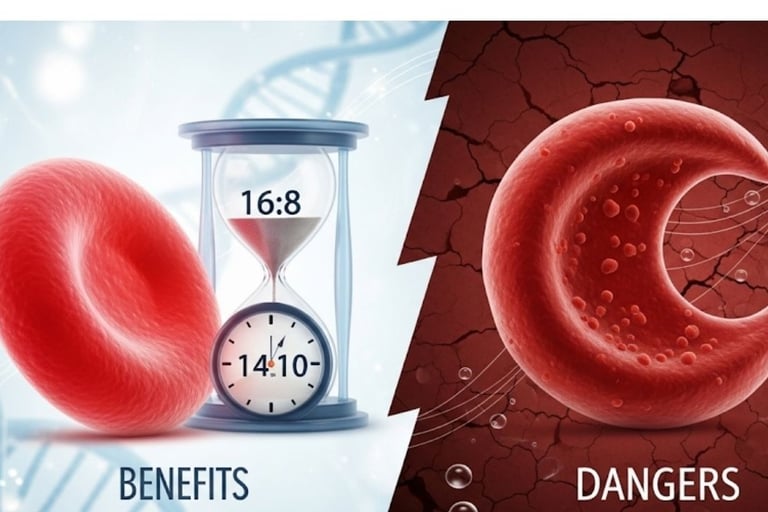
Health is a crown on the heads of the healthy that only the sick can see.
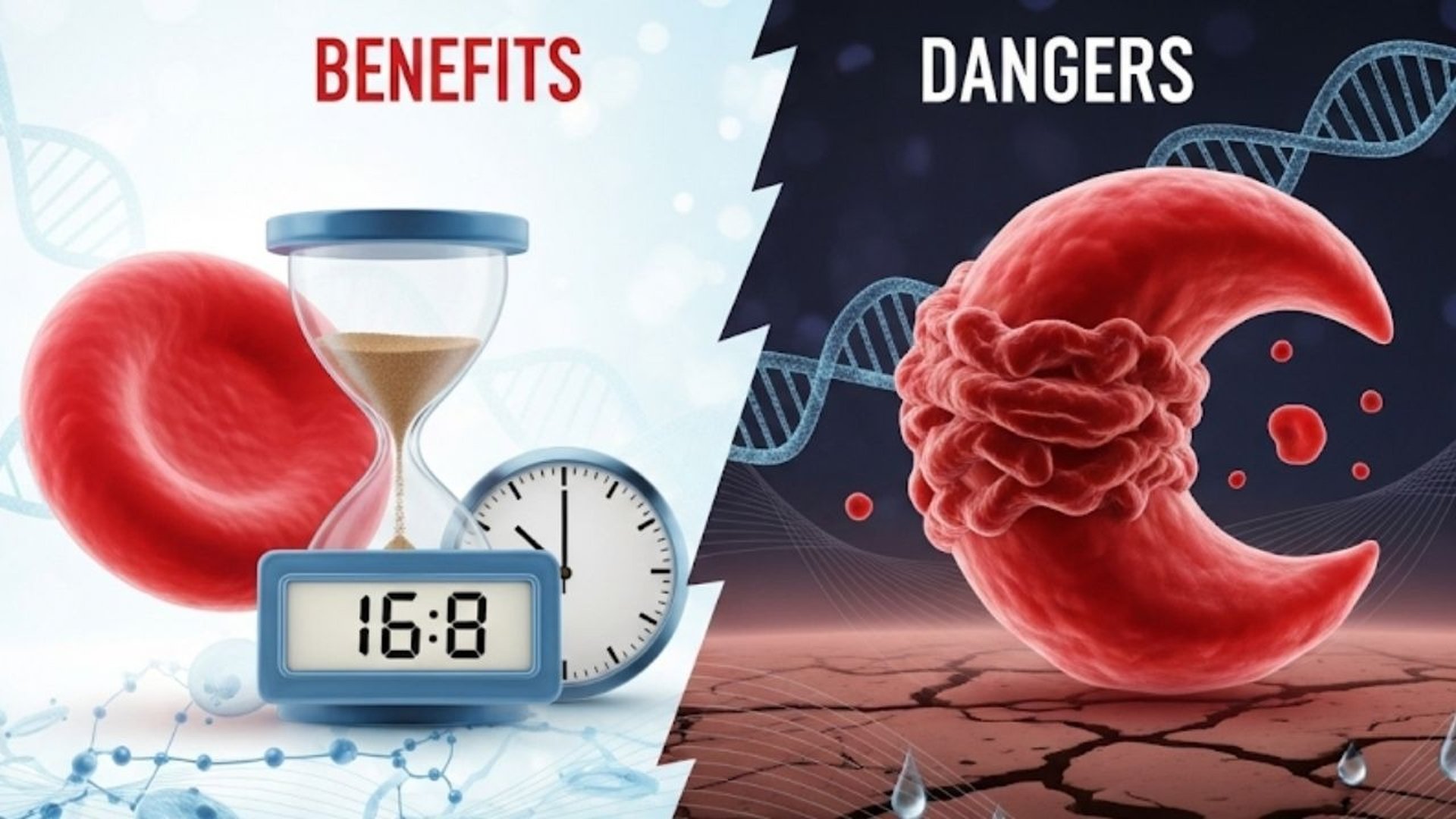
🌙🧬 Fasting and Sickle Cell Crises : A Delicate Balance
Fasting could potentially lessen inflammation and oxidative stress in sickle cell disease, but it also carries the risk of triggering crises due to dehydration
FASTINGKIDNY DISEASESHAEMATOLOGY
Dr Hassan Al Warraqi
10/1/202513 min read
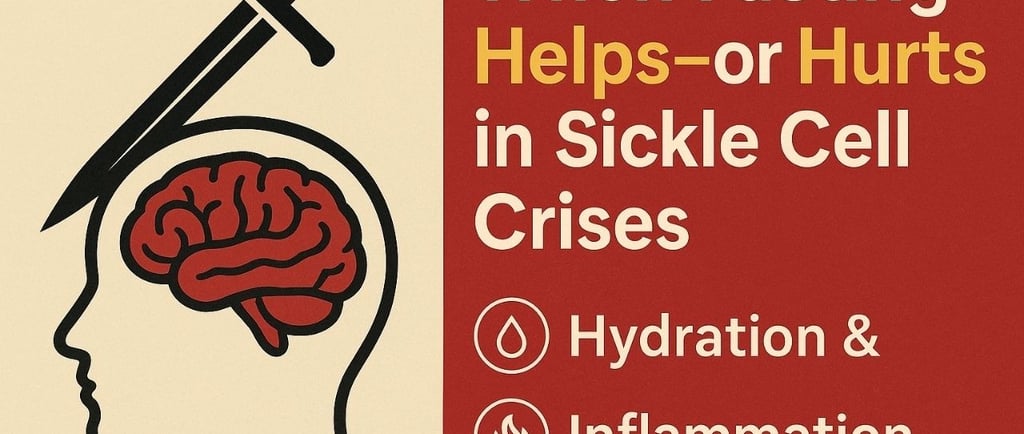

🌙🧬 Fasting and Sickle Cell Crises : A Delicate Balance
Fasting could potentially lessen inflammation and oxidative stress in sickle cell disease, but it also carries the risk of triggering crises due to dehydration. This article explores how to carefully consider both sides.
🌙🧬 Fasting and Sickle Cell Crises: A Paradox of Healing and Harm
Fasting in Sickle Cell Disease: Balancing Potential Benefits Against Real Risks
🌙🧬 Fasting and Sickle Cell Crises: A Paradox of Healing and Harm
I. Introduction: Understanding Sickle Cell Disease and Its Challenges
1.1. What is Sickle Cell Disease?
Sickle cell disease (SCD) is a genetic condition where a person inherits a faulty gene that affects hemoglobin, a protein in red blood cells responsible for carrying oxygen.
This faulty gene leads to the production of abnormal hemoglobin, called HbS.
The main problem in SCD is that when HbS loses oxygen, it clumps together, causing red blood cells to become stiff and take on a sickle (crescent) shape.
These sickled cells aren't flexible like normal red blood cells, so they get stuck in small blood vessels, blocking blood flow and leading to a painful and dangerous complication called a vaso-occlusive crisis (VOC).
But VOCs aren't just about blocked blood vessels.
They involve a complex chain reaction where sickled cells, activated white blood cells, damaged blood vessel linings, and blood proteins all play a role.
SCD is also marked by ongoing, low-level inflammation. Even when a patient feels well, their body shows signs of constant inflammation, including increased levels of blood-clotting factors.
This creates a higher risk for blood clots and other complications.
Markers found on platelets also indicate they are chronically being activated, also causing dangerous baseline thrombotic tendency.
1.2. What is Fasting, and How Might it Affect SCD?
Fasting means choosing not to eat for a specific amount of time, ranging from a few hours to several days.
Common types of fasting include eating only during certain hours of the day (time-restricted eating) and eating normally one day, then very little the next (alternate-day fasting).
During Ramadan, Muslims do Ramadan Intermittent Fasting(RIF ), which usually involves not eating or drinking anything from dawn to sunset (around 16 hours).
Fasting can cause changes in the body that can improve overall health and reduce inflammation.
However, people with SCD need to stay well-hydrated to avoid complications.
This raises a question: could the good things about fasting outweigh the dangers of limiting fluids for someone with SCD?
This piece will examine whether the potential anti-inflammatory effects of fasting might be worth the risk of dehydration and acidosis in people with SCD.
1.3. Weighing the Risks and Benefits: A Delicate Balance
When treating SCD, doctors focus on quickly relieving pain caused by VOCs, which can be triggered by things like infections, dehydration, or acidosis.
Giving fluids is a key part of treating a crisis.
Therefore, any diet that limits fluids could be risky.
This report will look at both the potential risks (the Hurt) and possible benefits (the Help) of fasting for people with SCD.
Because staying hydrated is so important for managing SCD, we need to carefully consider whether fasting can ever be safe for these individuals.
II. How Fasting Can Trigger Crises: Understanding the Risks (The Hurt)
2.1. Dehydration and Thickened Blood: Why Staying Hydrated is Crucial
Dehydration is a major trigger for VOCs in SCD.
The amount of water in the body directly affects how likely red blood cells are to sickle.
Sickling depends on both the amount and the concentration of deoxygenated HbS in the blood.
When someone doesn't drink enough fluids – like during fasting – their blood becomes more concentrated, increasing the amount of HbS in the bloodstream.
This is a serious concern.
More concentrated blood is also thicker, meaning it flows more slowly through blood vessels.
This can lead to blockages in small vessels and further reduce oxygen flow, creating a dangerous cycle where more sickling occurs.
The process of HbS polymerization is highly sensitive, so even slight dehydration can quickly cause a crisis.
This is why the standard treatment for VOCs includes giving fluids to increase blood volume, thin the blood, and reduce the concentration of HbS.
Sickled cells also become dehydrated themselves through the loss of potassium.
This loss is partially offset by an increase in intracellular sodium, but the net result increases the HbS polymerization.
2.2. Acidosis and the Bohr Effect
Acidosis, a condition where the body has too much acid, can also trigger sickling.
The Bohr effect explains how acidity affects hemoglobin.
It reduces the solubility of HbS, making it more likely to clump together.
Studies have shown that even a small increase in acidity can significantly increase the number of sickled cells.
When someone fasts for a long time, their body starts burning fat for energy, which can lead to a state called ketosis.
Ketosis can cause mild acidosis.
While this might not be a problem for healthy people, it can be enough to trigger sickling in someone with SCD, especially if they are also dehydrated.
This is similar to what happens during intense exercise when the body produces more acid, leading to sickling.
This suggests that people with SCD who exercise while fasting are at a much higher risk of a crisis.
2.3. Kidney Problems and Fasting
Many people with SCD have kidney damage, called sickle cell nephropathy, which makes their kidneys extra sensitive to reduced blood flow.
Studies of people doing RIF have shown that their kidney function can fluctuate significantly.
Specifically, creatinine levels (a marker of kidney function) tend to increase during fasting.
This suggests that the kidneys are under stress due to reduced water intake.
For people with SCD who already have kidney problems, repeated periods of reduced blood flow can further damage their kidneys and disrupt their overall health.
III. How Fasting Might Help: Exploring the Potential Benefits (The Help)
3.1. SCD as a Disease of Chronic Inflammation
The ongoing VOCs and organ damage seen in SCD are caused by chronic inflammation throughout the body.
Inflammation activates the lining of blood vessels, making it easier for sickled cells to stick and start the cycle of vaso-occlusion.
Research has shown that high levels of C-reactive protein (CRP), a marker of inflammation, is the strongest indicator and predictor of VOCs in children living with SCD.
Therefore, reducing this underlying inflammation is a major goal of treatment.
3.2. How Fasting Can Reduce Inflammation
Fasting can trigger changes in the body that have anti-inflammatory effects.
Studies have shown that fasting can lower levels of inflammatory substances in the blood, such as Interleukin-1 beta and Interleukin-6.
Reviews of fasting in the general population shows that fasting reduces inflammatory markers, such as tumor necrosis factor alpha and leptin.
One way fasting does this is by blocking the inflammation , a protein complex that triggers inflammation in response to stress or damage.
Fasting raises levels of arachidonic acid in the blood, which inhibits the activity of the inflammation .
The inflammation has been implicated in obesity, atherosclerosis, and neurodegenerative disorders.
Suppressing this inflammation may help reduce the burden of SCD.
Fasting can also affect immune cells in the blood.
Studies suggest that fasting reduces the number of inflammatory monocytes released into the bloodstream, essentially putting these cells into a less active state.
Monocytes can cause tissue damage, so reducing their activity during fasting could directly lower inflammation throughout the body.
If used correctly and consistently, fasting could potentially help stabilize the underlying condition of SCD patients by reducing inflammation, which could lead to fewer VOCs.
3.3. Autophagy and Red Blood Cell Health
Autophagy, the process where cells clean out and recycle damaged parts, is important for maintaining cell health.
In SCD, where red blood cells are constantly under stress, autophagy plays a key role.
Enhanced autophagic activity can protect against oxidative stress and improve RBC health.
However, dysregulated autophagy is known to exacerbate oxidative stress and increase hemolysis.
Fasting acts as a metabolic trigger for cellular autophagy.
Research suggests that fasting might offer treatment benefits by promoting this pathway in SCD.
For instance, Cathepsin B (a negative regulator of autophagy) is overexpressed in the reticulocytes of SCD patients.
IV. What Studies Show: Fasting and SCD – A Review of the Evidence
4.1. Ramadan Fasting Studies: What Have We Learned?
Most of the information we have about fasting and SCD comes from studies of people with SCD who fast during Ramadan.
These studies are usually small and rely on people to report their own experiences, which means they can be biased. But, they still provide valuable insights.
These studies often find that the rate of severe VOCs or hemolytic crises doesn't change much during Ramadan compared to before fasting.
This apparent stability might be, despite the risks of dehydration and acidosis, because people with more severe SCD are less likely to attempt fasting.
The studies mainly reflect the experiences of people with milder SCD who are careful to stay hydrated and manage their condition well.
4.2. Changes in Blood and Bone Marrow
Even though the frequency of crises might not change during fasting, studies have found significant shifts in blood and metabolic markers, suggesting that fasting does have a real impact on the body.
Creatinine Levels: As mentioned earlier, creatinine levels tend to rise during fasting, indicating stress on the kidneys due to dehydration.
Reticulocyte Count Dynamics: Reticulocyte counts (the number of immature red blood cells) drops during fasting and then rises again after fasting ends.
Since reticulocytes are usually elevated in SCD, the the acute drop during fasting and swift recovery once the fasting period was over may correlate with VOC development
Platelet Count Dynamics: Researches suggest a count drops during the fasting phase.
Platelets are key in the vaso-occlusive process, contributing to the hypercoagulable state.
The decline in reticulocyte and platelet counts suggests that limiting calories may temporarily affect bone marrow activity, decreasing their production.
Since both reticulocytes and activated platelets are highly adhesive and contribute significantly to the initiation of vaso-occlusion ,
this homeostatic shift may offer the observed stability in crisis rates.
The temporary reduction in the circulating load of these pro-occlusive cell populations may provide a compensatory stabilizing effect that offsets the immediate biophysical risks posed by dehydration and acidosis.
V. The Rebound Effect: Why the Period After Fasting Can Be Risky
5.1. The Post-Ramadan Spike in Complications
The most important thing to know about fasting and SCD is that the risks are often greater after the fasting period ends.
Studies show that the 30 days after Ramadan are a particularly vulnerable time for complications.
Patients with more SCD episodes or emergency room visits annually, have the highest risk of experiencing SCD-related complications within 30 days following Ramadan.
5.2. Possible Reasons for Delayed Complications
The surge in complications suggests that the temporary stabilization achieved during fasting is reversed and amplified when people resume normal eating and drinking.
The main reason for this is likely a combination of rebound hematopoiesis and heightened inflammation.
When the caloric restriction eases up, the body increases the production of cellular elements after the fast, leading to a surge.
this is the importance of day after the other fasting david fasting 3 or 4 days fasting per week
These platelets and reticulocytes are highly adhesive and prone to involvement in vaso-occlusion.
The sudden influx of pro-occlusive cells, coupled with the potential loss of the anti-inflammatory shield that was in practice, may overwhelm the system.
People with SCD already have a tendency towards blood clotting.
The rapid shift from reduced bone marrow activity to increased production of young blood cells creates instability, increasing the risk of blood clots and inflammation.
In the case of RIF cessation, the rebound causes a transient state of increased cellular and inflammatory activity that precipitates crisis in the already compromised microvasculature.
The intermittent metabolic stress and dehydration experienced over the 30-day period may cumulatively damage the endothelium and increase cellular adhesion.
When the cellular rebound occurs, the vascular system is less able to compensate, resulting in the observed spike in complications during the subsequent month.
VI. Guidelines and Recommendations: How to Approach Fasting Safely
6.1. Identifying High-Risk Patients
Because there aren't clear guidelines and the risk of complications is real, the decision to consider fasting should be made with the permission of doctor.
Medical history is the best predictor of how well someone will tolerate fasting and how likely they are to experience complications afterward.
Fasting is not advisable for those presenting with poor disease control or significant organ damage, particularly RIF, which involves fluid restriction.
Other reasons to avoid fasting include kidney disease or conditions that cause fluid loss (like vomiting or diarrhea).
6.2. Strategies for Promoting Safe Fasting
For individuals with stable disease who choose to fast, risk mitigation plans must be put in place:
Hydration and Nutrition : Drink a lot of water and nutrients during the non-fasting window to make up for the time of food restriction.
Maintaining euvolemia slows the sickling process by decreasing concentration and reducing blood viscosity.
Medication Adherence: It's important to take medications as a measure of disease-modifying therapies such as hydroxyurea, and it often requires adjustment to dosing schedules during the night.
Breaking the Fast Immediately : They have to be well educated and empowered to break the fast immediately if any symptoms of crisis (pain, fever, or difficulty maintaining oral intake) arise.
Close Monitoring: In addition to this, a mandatory requirement of Close monitoring by a treating doctor is required.
6.3. What We Still Need to Learn
Our current understanding is based on studies of Ramadan fasting, which makes it difficult to separate the benefits of calorie restriction from the risks of fluid restriction.
The hurt (acidosis/dehydration) is considered a biophysical crisis risk, while the help (anti-inflammation/autophagy) is seen as a chronic metabolic benefit.
Future studies should focus on forms of fasting that don't restrict fluids, such as time-restricted eating, to better understand the anti-inflammatory and cellular benefits of calorie restriction.
If intermittent calorie restriction can maintain the benefits of inflammasome inhibition and monocyte de-activation without the increase risk hemoconcentration and acidosis, then fasting principles may be developed as a viable treatment strategy for SCD management.
Until we have more information, fasting, especially when it involves fluid restriction, carries significant risks for most SCD patients.
====================================-----------------------------------------------------------------
Dr. Hassan Alwarraqi’s approach to fasting
and how it relates to patterns like:
“Day after the other fasting” → known as Alternate-Day Fasting (ADF).
“David fasting” → often understood as the Daniel/David pattern, meaning fasting on certain days (like the Biblical prophet’s regimen), sometimes linked to eating modestly on some days and abstaining on others.
“3 or 4 days fasting per week” → essentially a modified fasting strategy (like the 5:2 diet or 4:3 fasting).
🧾 Explanation in Dr. Alwarraqi’s Integrative Fasting Framework
Alternate-Day Fasting (صيام يوم ويوم)
Proven to reduce inflammation, oxidative stress, and insulin resistance.
Suitable for patients who can’t manage long fasts but still want metabolic benefits.
Helps with conditions like fatty liver, metabolic syndrome, and possibly cognitive decline.
David/Daniel Fasting (صيام داوود)
Traditionally: fasting every other day, or fasting certain days with limited foods.
Spiritually rooted, but also medically useful to rest the gut and regulate immune responses.
Balances discipline with sustainability.
3–4 Days Fasting per Week
Stronger metabolic reset.
Can enhance autophagy, reduce inflammation, and may aid in chronic conditions (like autoimmune or degenerative diseases).
Needs careful hydration and nutrition on eating days to avoid malnutrition.
✅ Key Insight:
Dr. Hassan Alwarraqi https://h-k-e-m.com/ emphasizes that these fasting rhythms are flexible therapeutic tools, where the choice of pattern (alternate-day, David fasting, or 3–4 days per week) depends on the patient’s condition, resilience, and goals. Each regimen is a balance between healing potential and risk of depletion.
FAQs – Fasting and Sickle Cell Crises: A Delicate Balance
1. Can people with sickle cell disease fast safely?
Some patients with stable SCD may tolerate fasting if hydration and medical monitoring are ensured.
However, fasting that restricts fluids (like Ramadan fasting) carries higher risks and must be approached with extreme caution.
2. What is the main danger of fasting in SCD?
Dehydration and acidosis. Both can thicken blood, increase HbS polymerization, and trigger vaso-occlusive crises.
3. Are there benefits to fasting for SCD patients?
Yes. Fasting reduces inflammation, lowers adhesion of blood cells, and may improve autophagy.
These changes could help reduce long-term complications.
4. Why do complications increase after Ramadan fasting?
Because of the rebound effect: once fasting ends, the bone marrow rapidly produces young blood cells (reticulocytes, platelets), which are highly adhesive and pro-clotting. this way alternate day fasting .
This can overwhelm fragile blood vessels.
5. What types of fasting may be safer for SCD patients?
Dr. Hassan Alwarraqi suggests exploring:
Alternate-Day Fasting (ADF): fasting every other day with fluids allowed.
David Fasting (صيام داوود): fasting on specific days, balancing discipline with sustainability.
3–4 days per week fasting: strong anti-inflammatory effect, but requires careful hydration.
6. What is the key takeaway?
Fasting in SCD is a double-edged sword — it may help reduce inflammation but also carries real risks.
It should only be attempted with medical supervision, proper hydration, and individualized planning.
https://h-k-e-m.com/-fasting-and-sickle-cell-crises-a-delicate-balance
====================================
—----------------------------------------------------------
https://h-k-e-m.com/-fasting-and-sickle-cell-crises-a-delicate-balance
Dr. Hassan Alwarraqi – physician and researcher at H-K-E-M.com – explores the paradox of fasting in sickle cell disease, highlighting both risks and potential benefits. His integrative fasting framework (Alternate-Day, David, or 3–4 days per week) offers flexible approaches that balance healing and harm.
—----------------------------------------------------------
================================================
🦠 URTI : Dr. Hassan Al-Warraqi’s Way of Treating Infection
🦠 URTI : Dr. Hassan Al-Warraqi’s Way of Treating Infection
🔹 1. Foundational Principle – Support, Don’t Suppress
Most URTIs are viral, self-limiting, and worsened by unnecessary antibiotics. Dr. Al-Warraqi emphasizes:
Do not rush into antibiotics unless there are signs of bacterial complications (severe tonsillitis, sinusitis with pus, pneumonia).
Focus on enhancing the body’s defense mechanisms instead of attacking the microbe alone.
🔹 2. Fasting as a Therapeutic Reset
Short intermittent fasts (16–24h) reduce systemic inflammation, support autophagy, and give the immune system time to rebalance.
Fasting starves pathogens of excess glucose while upregulating immune surveillance.
Hydration and electrolytes must be maintained during fasting to avoid worsening weakness.
🔹 3. Bee Products as Antimicrobial and Healing Tools
Honey: antibacterial, antiviral, and soothing for throat pain. (e.g., Manuka honey for strep and viral pharyngitis).
Propolis: boosts immune activity, reduces viral replication.
Royal Jelly & Bee Venom (apitherapy): potential modulators of inflammation in chronic sinusitis and resistant infections.
🔹 4. Microbiome & Gut–Lung Axis
Probiotics (especially Lactobacillus & Bifidobacterium) help restore microbial balance disrupted by antibiotics or infection.
Fermented foods + fasting strengthen the gut-lung immune axis, improving resistance to recurrent URTIs.
🔹 5. Targeted Supportive Therapies
Steam inhalation with essential oils (thyme, eucalyptus, peppermint) → mucolytic + antimicrobial.
Saltwater gargles & nasal rinses → mechanical clearance of viral load.
Vitamin D, Zinc, Quercetin → immune modulators shown to shorten URTI duration.
🔹 6. Stepwise Approach (Dr. Al-Warraqi’s Algorithm)
Early viral stage: fasting + honey + hydration + herbal support.
Prolonged fever or purulent signs: add targeted antimicrobial (preferably natural first, antibiotics if clear bacterial infection).
Chronic or recurrent cases: integrate fasting cycles, apitherapy, and microbiome repair.
✅ Key Insight:
Dr. Hassan Al-Warraqi reframes URTI treatment as balancing infection control with immune strengthening. Instead of suppressing every symptom, he uses fasting, honey, and microbiome therapy to help the body relearn equilibrium, intervening with antibiotics only when truly necessary.
================================================
—----------------------------------------------------------
